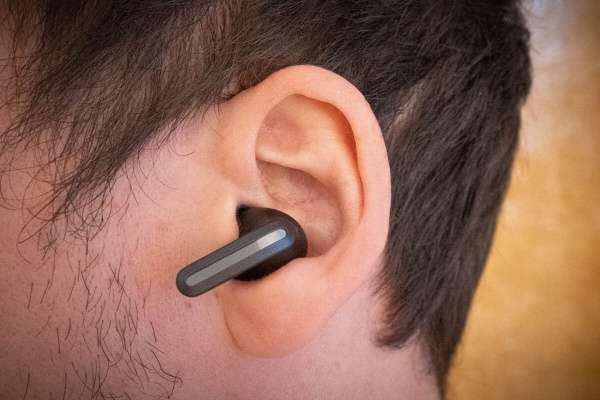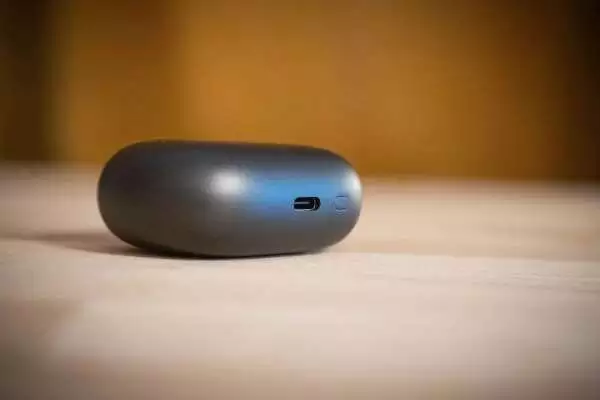On paper, the Xiaomi Redmi Buds 4 Pro have a lot going for them. Nine-hour battery life, twin transducers, LDAC compatibility, multipoint Bluetooth, active noise reduction… all for less than a hundred dollars. However, the data sheet is not everything, and to find out how much Xiaomi’s wireless headphones are worth, check out their full evaluation.
Technical Sheet
| Model | Xiaomi Redmi Buds 4 Pro |
|---|---|
| Format | in-ear headphones |
| Removable battery | No |
| Microphone | Yes |
| OS compatibility | Android, iOS |
| Active noise reduction | Yes |
| Autonomy announced | 36 hours |
| Bluetooth Version | 5.3 |
| Price | 99 $ |
Design
Xiaomi provides a rather traditional appearance for its earphones, with stems and in-ear tips. Enough to provide enough support when the headphones are placed in the ear, since this design option has been demonstrated throughout time.
The Redmi Buds 4 Pro, on the other hand, stand out for their unique features. This is the case with the tactile surface, which is coated with an imitation metal plastic strip to accentuate the rod’s line. However, the headphones have a rather simple plastic that does not emanate quality or firmness. Without quibbling too much, considering their price of 100$, we anticipate a bit less raw plastic than Xiaomi offers here. A sense reinforced by the matte look of the headphones in the black version I was able to test – they also come in white.

Once in the ear, the headphones are comfortable, with good support. I had the opportunity to wear them for several consecutive hours without their size pressing against the cartilage of my ear or, at least, without it really bothering me. It must be said that they are helped in this by their weight of only 5 grams on the scale.
Note also that Xiaomi provides its headphones with three pairs of tips. Enough to ensure that you will find a shoe that fits your foot – or a mouthpiece for your ear canal.
The Case Of The Xiaomi Redmi Buds 4 Pro
The Redmi Buds 4 Pro, like other wireless headphones, come with a charging box. With measurements of 49 x 60 x 23 mm, this is very small. A nice point, because it will fit even more easily into a jeans pocket (including the fob pocket) and, presumably, a jacket pocket or a purse.

The Redmi Buds 4 Pro cover does not play the uniqueness card, instead offering a very conventional pebble-type style with a rounded appearance. On the front, a single LED indicates the amount of charge or pairing of the headphones. A USB-C port may be found on the bottom. Finally, Xiaomi has included a pairing button next to the socket. In a nutshell, everything is really traditional. Unfortunately, we would have liked the inclusion of a second LED to distinguish the headphones’ autonomy from that of the enclosure.
Water Resistance and Sports Use Of The Xiaomi Redmi Buds 4 Pro
The Xiaomi Redmi Buds 4 Pro have an IP54 rating. This means they are resistant not just to dust, but also to splashes, and may thus be worn in wet weather or in a sweaty sports scenario.
In fact, I ran twice with the headphones on and experienced no pain. The headphones stayed in place, and I didn’t feel like they were attempting to escape from my earphones.
Use And Application
When connected to a Xiaomi smartphone running the MIUI system, the Redmi Buds 4 Pro only provide a rapid pairing feature. Don’t be alarmed! If you have another phone or wish to connect them to a PC, click the button on the case to turn the headphones to pairing mode, then choose them in your device’s Bluetooth settings. However, we would have preferred a simpler approach, such as Google Fast Pair or Microsoft Swift Pair.
READ ALSO : Nokia X30 5G Full Review
The Touch Controls Of The Xiaomi Redmi Buds 4 Pro
The Xiaomi Redmi Buds 4 Pro have sensitive surfaces on the stems, as seen above. These surfaces include various controls by default:
- Double press: play / pause.
- Triple press: next title.
- Long press: noise reduction.
As a result, regardless of the earpiece with which we engage, we have identical controls from the start.

Nonetheless, the Xiaomi Earbuds app allows you to personalize and expand these functions by separating them on the left and right. As a result, we may assign the rewind function to the triple press on the left or the voice assistant function to the long press on the left or right. You may also modify the sound volume by tapping three times on the left or right. This, however, has the effect of overriding the track change.
The Xiaomi Earbuds App
We’ve previously mentioned it, but the occasion will be commemorated with a white stone: Xiaomi has finally released a control app for its wireless headphones. Previously exclusive for the Chinese market, Xiaomi Earbuds will allow you more control over the brand’s wireless headphones – without having to go via a third-party developer’s Mi Buds M8. This is especially noteworthy given that, until recently, only Xiaomi smartphone owners have had complete control over their headphones via their smartphone’s Bluetooth settings. Xiaomi may now sell its headphones to all smartphone owners, rather than only those who are currently clients.
Users will be able to pick between noise reduction mode, passive mode, and transparent mode inside the Xiaomi Earbuds application. They will also be able to tweak the touch controls and upgrade the firmware of their headphones, as previously shown.



In addition to these relatively standard functions, such as the ability to view the battery level in each earphone, the application will allow you to ring the earphones to easily locate them, activate or deactivate in-ear detection (to pause the music when removed), and perform a fit test to ensure that the ear tips are the correct size to provide the best passive isolation and, logically, the best active noise reduction.
It’s also worth noting that the Xiaomi Earbuds app lets you enable the dual multipoint Bluetooth connection.
The Bluetooth Connection Of The Xiaomi Redmi Buds 4 Pro
Bluetooth version 5.3 is supported by the Xiaomi Redmi Buds 4 Pro. Furthermore, the headphones are marketed as being able to connect to two devices at the same time. To accomplish this, you must first select the option in the smartphone app, then place the headphones in the charging case before beginning a fresh pairing.
If you connect the Redmi Buds 4 Pro to a smartphone and a computer at the same time, the device providing the most recent sound will methodically take over the reading, pausing the other source. This capability is quite useful on a daily basis since it allows you to keep the headphones in your ears all day and use them with both your computer and your smartphone. In fact, keep in mind that the Bluetooth connection may be unstable.

I was able to hear a few infrequent but notable microcuts by connecting the headphones through Bluetooth to a smartphone, using the LDAC codec, and going for a run with them for over an hour. The same may be said for multipoint management. Headphones may take a few seconds to recognize which source is meant to take over.
In terms of Bluetooth latency, which is inherent to this wireless technology, I was able to measure a delay of 190 ms in SBC and 181 ms in LDAC. However, the Xiaomi Earbuds program does not enable you to select between the two LDAC modes: priority for stability or priority for quality.
Noise Reduction
Xiaomi claims that it has installed three microphones per earphone to provide active noise reduction in the Redmi Buds 4 Pro, two of which are especially devoted to ANC with a microphone positioned inside to analyze noises that have passed the isolation filter. passive.
According to the Chinese company, this would allow them to give noise reduction of up to -43 dB with frequency reductions ranging from 30 to 3000 Hz. Of course, the company does not define the sound frequency at which this result of -43 dB is attained. Xiaomi, always one to hold back on boasts, claims that their headphones can block “up to 99.3% of ambient noise “.

You may as well not go overboard: the Redmi Buds 4 Pro’s noise reduction is underwhelming. We are certainly light years away from what recent high-end models such as the Bose QC Earbuds 2 or the Apple AirPods Pro 2 can offer, but even worse, Xiaomi’s headphones offer much less effective noise reduction than most headphones I’ve had the opportunity to test in the last two years – including models launched in the same price range.



The differences between the noise reduction mode, even when set to maximum, and the simple passive isolation provided by the pads are negligible. The active reduction merely muffles the most dangerous sub-bass frequencies. I didn’t notice a major difference in voices, treble, or bass while switching from passive to active noise reduction. The headphones, on the other hand, provide three levels of noise reduction: light, balanced, and deep. There is also a ” adaptive noise cancellation ” option, which automatically adjusts the ANC based on the degree of noise pollution. Even with Deep Mode enabled, I noticed little change with ANC turned off.
Dual Transparent Mode
The headphones include two transparent modes in addition to noise suppression. The first, more traditional option, simply restores the sound collected by the microphones in the headphones. The portrayal is quite excellent and natural-looking. A second setting, “improve speech,” reduces most ambient noise while restoring middle frequencies in the headphones.


This time, the depiction clearly lacks naturalness and can rapidly become uncomfortable when frequencies are lost, particularly near the bottom of the spectrum. On the other hand, it has the advantage of actually doing what it is designed to accomplish.
Audio
Headphones featuring dual-driver sound systems have become available in recent months. This was already the case with the Huawei FreeBuds Pro 2, Honor Earbuds 3 Pro, and Samsung Galaxy Buds 2 Pro, and it is now the case with the Xiaomi Redmi Buds 4 Pro.

As a refresher, this sound architecture will allow you to allocate some frequencies – often the treble – to a secondary loudspeaker, allowing you to focus on the bass and middle. This technique, when properly processed, will generate a more detailed sound since each transducer may focus on its own sound frequencies. Xiaomi has used a 10mm aluminum alloy primary driver for the bass and midrange, and a 6mm titanium driver for the treble.
The headphones are also Hi-Res Audio Wireless certified, owing to the inclusion of the LDAC codec alongside the standard SBC and AAC. As a result, they can reproduce data encoded up to 24 bits at 96 kHz.

The frequency response curve of Xiaomi’s headphones indicates a concentrate on the middle, with treble practically lost – with the exception of extremely high frequencies – and bass indented. When we listen, we actually hear a sound that is severely weak in foundation. The Xiaomi Redmi Buds 4 Pro have a fairly gaunt sound signature that emphasizes voices a lot.
This is the case with Billi Eilish’s Bad Guy, a title that generally gives the bass layer in the background center stage to accompany the singer’s vocals. In this case, it is Billie Elish’s voice that plainly has the upper hand.
Given the low depth of the headphones, this imbalance is already damaging, but it is made worse by the fact that the frequencies sent forward, between 1000 and 2500 Hz, are precisely those that are naturally amplified by the duct auditory. As a result, the sound is unpleasant, dry, and malnourished. Everything lacks width, and even on frantic electro titles like Phantom Pt. II of Justice, it’s difficult to detect anything other than mid-frequency saturation. Beethoven’s Symphony No. 5 suffers from a terrible lack of basis, with an utterly skeletal interpretation.

It is not enough to have two transducers per earphone; you must also tune them appropriately, and it is just here that the Redmi Buds 4 Pro fail. Fortunately, we can significantly modify the character of the headphones by enabling the “enhance the bass” audio effect in the Xiaomi Earbuds app, but, once again, in the lack of a genuine band equalizer, we are unable to improve the rendering as we would want.
Also worth noting is Xiaomi’s ” immersive sound ” option, which is described as “compatible with diverse audio sources and playback devices ” and is intended to immerse you in spatial sound when viewing films. When tested on YouTube, Netflix, or Disney+, including with Dolby Atmos content, this option does not provide much more value than the standard mode, therefore we will stick with it.
Micro
The Xiaomi Redmi Buds 4 Pro include three microphones for noise reduction and sound pickup during voice calls.
During calls, though, Xiaomi’s headphones fail to pick up your speech. It will be significantly impacted if it lingers much above the surrounding sounds. The person on the other end of the line will be easily distracted by the sounds surrounding you, and the discussion will rapidly become frustrating for him. Even in a calmer environment, the headphones will tend to ring plosives, that is, noises beginning with ” t “, ” p “, ” b “, or ” b”.
As a result, we don’t have a sufficiently believable call experience here, and the noise reduction will be too inefficient to truly suppress ambient sounds while also being too disruptive for recording the voice.
Autonomy
Xiaomi claims up to 9 hours of battery life with the headphones alone – without defining the codec or noise reduction – and up to 36 hours, or three extra charges, with the case.
To put the Redmi Buds 4 Pro’s battery life to the test, I started playing music by connecting the headphones to a smartphone in LDAC and setting the volume to 75%. Under these conditions, the headphones were well short of the advertised nine hours of battery life. After 3h16, the left earphone ran out of power. After 3:20, the right earphone arrived four minutes later. We’re familiar to discrepancies between the autonomy stated by manufacturers and the measures performed, but one of this scale is bound to disappoint.

Xiaomi promises two hours of readings retrieved in five minutes while charging the headphones in the case. I was able to see a full charge on my side in approximately an hour.
The case can only be charged through the USB-C port. Xiaomi also includes a short USB-A to USB-C connection but no power adapter. The Redmi Buds 4 Pro case is also incompatible with Qi wireless charging by induction.
Price and Release Date
Since the beginning of October 2022, the Xiaomi Redmi Buds 4 Pro have been available in white or black. They cost 99.99 dollars each.


